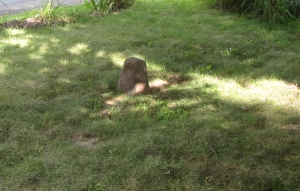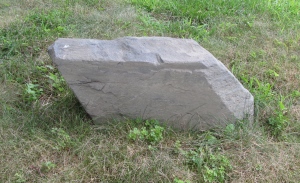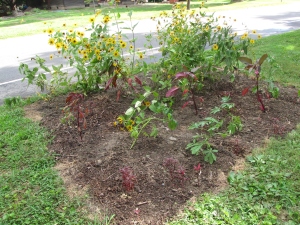 IT TOOK THREE TRIES, but I finally got the flower boxes right. Two of them grace my front porch, facing the sidewalk and street beyond, centered on either side of wide wooden steps atop a thirty-inch-high wall. They symbolize the dual nature of my gardens — planted for my enjoyment but part of the public domain.
IT TOOK THREE TRIES, but I finally got the flower boxes right. Two of them grace my front porch, facing the sidewalk and street beyond, centered on either side of wide wooden steps atop a thirty-inch-high wall. They symbolize the dual nature of my gardens — planted for my enjoyment but part of the public domain.
When I returned here four summers ago after a one-year absence, it became my sole responsibility to maintain the landscape. Previously, I had primary responsibility for the broad spaces of the perennial beds, largely out of public view.
My first attempt to conform my thinking to the narrow, unfamiliar confines of the copper flower boxes — thirty-six inches long, nine inches wide, and eight inches tall — was a disaster. Starting with some familiar staples of previous years, I added some of my own selections, my first tentative steps at asserting my personality on this alien soil.
Neither approach worked. The heliotrope, trailing blue lobelia, and scented purple petunias that flourished under my predecessor’s care did not respond as well to my ministrations, and the lisianthus I chose for its pastel green foliage and elegant, rose-like purple and white blossoms, was ill advised. They grew taller and spindlier in the flower boxes than I remembered them mixed in with other flowers at ground level, and by August they became a disheveled mass of bent and fallen stalks.
Last year I decided to grow flowers by seed in the boxes rather than transplanting annuals. I kept it simple: sky blue morning glories to climb up netting hanging from the porch roof, and contrasting red and orange nasturtiums that would spill gracefully over the front, an idea inspired by the hanging nasturtiums overlooking Fenway Court at the Isabella Stewart Gardner Museum courtyard in Boston.
The experiment began beautifully, even if the seedlings were for my eyes only, too small to be enjoyed from the sidewalk. But the delicate nasturtiums, like the lisianthus, grew far better in shade and the company of other plants. With the arrival of summer, the exposed nasturtiums shriveled in the heat just as they were about to bloom, before they had begun to trail. The morning glories fared better, but took all summer to climb the netting and blossom, and they were never as thick as I had hoped or imagined. I stuck in some marigolds from a back garden to see the summer through, but the results were decidedly mediocre.
This year the flower boxes have been restored to their former glory, anchored by sturdy geraniums in white, crimson, and salmon. Each box has blue lobelia, and this year they are holding up. A lemon-yellow petunia with ruffled, penny-sized flowers has bloomed all summer. For contrasting tones I chose licorice, adding feathery, silver-green lobes of color. Now, at a time of year when the boxes are sometimes beginning to strain under summer’s heat, they remain full and lush.
MY GROWING AWARENESS of the prominence of the flower boxes for the many passersby — combined with the profusion of plants in my back gardens — has led me to gradually rethink my entire front yard with a civic view in mind. It began last year, when the persistent weeds around the base of an elm tree led me to fight back, not by pulling them but by supplanting them with perennials.
The trend accelerated this spring when I relocated half a dozen daylilies to my front lawn from overgrown clumps in need of separating. My efforts have now mushroomed into a major project to gradually transform a broad swath of incidental lawn to designed landscape. While the pleasure of the planning and work is all mine, the results are decidedly democratic.
My efforts, though, are guided as much by necessity as altruism. Many of my best perennials are being buried by competing species out back, and must be moved to thrive (or in some cases, even to survive). I mow my lawn with a hand-powered reel mower, too, and while pushing it provides good exercise, having less grass to mow is not entirely unwelcome.
The space I describe is flat, a perfect rectangle measuring about 30 feet wide and 120 feet long, bordered lengthwise by street and sidewalk, and on either end by my paved drive and neighbor’s adjoining lawn. There are two trees: to the east, its canopy just reaching the drive, is a 35-foot tall Norway maple with perfect symmetry and stunning reddish-purple foliage; near the western edge, a much younger Princeton elm (this being Elm Street, after all), which I planted as a sapling twelve years ago. It suffered significant damage in 2011’s freak Halloween snowstorm but has recovered nicely, and is now nearly as tall as the maple.
A storm drain sinks ominously to the west of the elm, but otherwise the grass rectangle is clear for my use and imagination. Until last year, I had limited my overtures to a few clusters of daffodil and tulip bulbs scattered in the grass. The rest I dutifully mowed.
The first garden to appear, beneath the elm, consists of a more-or-less traditional mix reflecting both surpluses and my desire for continuous bloom, including beardtongue, bee balm, butterfly bush, hosta, iris, lobelia (the tall perennial), painted fern, rose campion, and sedum. In year two, it has done quite well, and I have made a few additions.
It is a modest beginning, but certainly an improvement over the blight of weeds that had been choking the elm, and already it is capable of turning heads. The wide-open spaces and the spreading habits of many perennials now have me thinking more expansively about the rest of this bare landscape. Seeing the daylilies flourish in their new setting curled gently along the drive has further influenced my design.
 BEFORE I ADDED MORE PLANTS, though, I needed some rocks. I have always accented my gardens with stones, retrieving them from great distances on occasion when I was particularly moved by an unusual shape or color.
BEFORE I ADDED MORE PLANTS, though, I needed some rocks. I have always accented my gardens with stones, retrieving them from great distances on occasion when I was particularly moved by an unusual shape or color.
For someone like me raised on New England’s rocky soils, Hatfield’s alluvial loam is a rockless revelation, so I needed some imports. I began with a shapely piece of sandstone from a spreading wall at a friend’s house in Connecticut. About fourteen inches wide at its base and over a foot tall, it tapers slightly to about six inches wide at its peak, and looks perfect, a miniature tombstone propped upright in the grass between lilies and maple.
Another friend brought several smaller rocks from his home in nearby Hadley, including a chunk of white granite that contrasts beautifully with a new bed of painted ferns in front of a stand of hemlocks, and a grapefruit-sized rock with a thick white stripe from Block Island. A second, smaller piece of sandstone went in among the daylilies, near two odd-shaped, brick-sized souvenirs from a recent hike up Black Mountain at Lake George. Their meaning is particular to me, but their visual impact universal.
 Despite their relative scarcity, I still felt I needed something from the fields of Hatfield, where I walk daily. I began scouring the landscape, and was soon rewarded with two good-sized rocks stirred up along the edge of a potato field, plus a large, trapezoidal green stone, more than two feet long, five inches thick, and nearly a foot high. It was nearly buried in the soil; I almost walked past it. Too heavy to carry, I drove my car along farm roads to retrieve it, and could barely lift it above the threshold of my car door. It bobbed precariously all the way home where I leaned it against the passenger seat.
Despite their relative scarcity, I still felt I needed something from the fields of Hatfield, where I walk daily. I began scouring the landscape, and was soon rewarded with two good-sized rocks stirred up along the edge of a potato field, plus a large, trapezoidal green stone, more than two feet long, five inches thick, and nearly a foot high. It was nearly buried in the soil; I almost walked past it. Too heavy to carry, I drove my car along farm roads to retrieve it, and could barely lift it above the threshold of my car door. It bobbed precariously all the way home where I leaned it against the passenger seat.
I pulled up in front of the area where I wanted to locate it, and managed to roll it end to end several times before it finally landed with a thud in its final resting place, opposite the sandstone beneath the maple’s canopy, a nice contrast to its foliage and the reddish sandstone. A second, smaller rock from this trip fit nicely against the thin metal post with the sign announcing Elm Street’s historic district, just west of the sunken storm drain.
MY STONEWORK COMPLETE, I began setting out plants, starting with a generous clump of ribbon grass in the middle of the lawn. Rather than waging a duel to the death with its neighbors, here it can be appreciated and encouraged to spread. At a safe distance outside the ring of the elm garden, I planted a young baptisia. Also known as false indigo, it is one of my favorites, with pea-green foliage and rich purple blossoms in May. I have several in my yard, and the one that flourishes most in full sun is as big and bushy as a shrub. I heeded this in giving the young transplant plenty of shade-free room to grow.
I moved seven young butterfly bushes to a teardrop-shaped bed extending from the base of the historic district sign, and scattered marigold seeds among them to provide color this year. Tall, showy, and fragrant, the butterfly bush should make a dramatic splash next summer. I placed some purple morning glories plants around the rock on the other side, but these do not generally transplant well. Should they make it, though, the post should prove ideal for climbing.
 There are two ground covers, both gifts: snow-on-the-mountain (also known as bishop’s weed), with pale green and cream-colored foliage, from a great gardener in her mid-90s who can no longer tend her beds (the two transplants are separated by a robust cluster of bright orange cosmos, another gift); and Houtteynia Cordata “Chameleon,” a native of Korea with reddish-tinged leaves (planted beneath and behind the maple, near the street). The same friend gave me several young Rose of Sharon bushes, and I placed these along my western border. If even one of them survives (I am optimistic), they will visually anchor the property line.
There are two ground covers, both gifts: snow-on-the-mountain (also known as bishop’s weed), with pale green and cream-colored foliage, from a great gardener in her mid-90s who can no longer tend her beds (the two transplants are separated by a robust cluster of bright orange cosmos, another gift); and Houtteynia Cordata “Chameleon,” a native of Korea with reddish-tinged leaves (planted beneath and behind the maple, near the street). The same friend gave me several young Rose of Sharon bushes, and I placed these along my western border. If even one of them survives (I am optimistic), they will visually anchor the property line.
 Three new gardens will complete the transformation of this previously level landscape, created by successively moving a nine-foot by eleven-foot tarp from place to place every few weeks — just long enough to kill the grass beneath and make for easier digging. Last week I completed the first of these new beds, in the far western corner of my lot beyond the butterfly bush, populating it within hours of removing the tarp.
Three new gardens will complete the transformation of this previously level landscape, created by successively moving a nine-foot by eleven-foot tarp from place to place every few weeks — just long enough to kill the grass beneath and make for easier digging. Last week I completed the first of these new beds, in the far western corner of my lot beyond the butterfly bush, populating it within hours of removing the tarp.
Working steadily before breakfast, I first transported about twenty helianthus plants to the newly prepared bed shovel by shovel from my back gardens, where they are hardly missed. Amaranth and cleome, both annuals, arrived the next day from my Hadley friend.
 The helianthus is still in bloom; while this was not an ideal time for transplanting the perennials, they added an instant splash of color (with masses of bright orange, daisy-like flowers), and height (four or five feet tall) to this formerly flat space. The annuals, as much as three feet tall, are still recovering from the shock of their move with the aid of copious watering, but the amaranth’s thick red stalks and purple flower clusters, and the cleome’s spidery pink-and-white blossoms eventually should mesh well together.
The helianthus is still in bloom; while this was not an ideal time for transplanting the perennials, they added an instant splash of color (with masses of bright orange, daisy-like flowers), and height (four or five feet tall) to this formerly flat space. The annuals, as much as three feet tall, are still recovering from the shock of their move with the aid of copious watering, but the amaranth’s thick red stalks and purple flower clusters, and the cleome’s spidery pink-and-white blossoms eventually should mesh well together.
Except for dozens of bulbs I will add this fall to provide spring color, this bed is now complete. The hardy helianthus can work things out with the amaranth and cleome (prolific self-seeders) in earnest beginning next year. I expect them all to bear visual fruit.
The second garden site, nearly in front of the house bordering the street, will remain beneath the tarp until mid-month. I will then transplant bee balm nearest the street; it is prolific, and its quirky red blossoms on four- to six-foot stems are irresistible to honeybees and hummingbirds, among others, and particularly impressive en masse.
Along the front edge I will plant several irises rescued from the back gardens, where they have been overwhelmed by taller perennials to the point of near extinction. They will provide early season color while the bee balm grows. Between the two will be Ozark sundrops, half the height of the bee balm with a bright yellow blossom that will contrast nicely in shape and color. Maintaining the theme of simplicity, there will be little else, if anything, in this garden, except for more spring bulbs.
The final destination for the tarp after I plant the second bed will prepare the soil for an herb garden in the quadrant of lawn framed by my porch, two sidewalks, and driveway. My chive plant, while healthy, is distant from my kitchen and increasingly dwarfed by lady’s mantle; my lavender suffers from dryness and neglect in its present location; and chamomile grows wild along the potato fields. These will anchor the new space, along with plants like thyme and oregano.
Transplanting perennial herbs will begin in September, in time for them to get established before frost. But I am equally looking forward to planting annuals like basil, dill, and parsley next year for my culinary pleasure, while the public can feast its gaze.
The early returns from this project to enhance my private and public landscape have been mostly positive. Two seldom-before-seen neighbors stopped by while I was transplanting to praise my efforts, and I see walkers slowing down and looking at the new flowers, which is gratifying.
But I will need to re-transplant two daylilies further back from the sidewalk. Where I initially placed them, alas, they are too close to the path of habitually urinating dogs.
